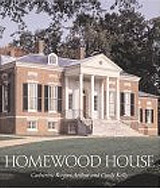Book Review
Homewood House
By Catherine Rogers Arthur and Cindy Kelly. Baltimore, MD: Johns Hopkins University Press, 2004; 192 pp., illustrations, notes, appendices, index; cloth $35.00.
 |
Catherine Rogers Arthur, curator of Homewood House Museum, and Cindy Kelly, former director of Historic Houses of The Johns Hopkins University, collaborated to produce Homewood House, a copiously illustrated and scholarly study of this historic house (begun 1801) in the midst of urban Baltimore, Maryland. Charles Carroll of Carrollton, the only Catholic signer of the Declaration of Independence, paid for the construction of the house on 130 acres of undulating farmland in view of Baltimore's harbor as a wedding gift to his son, Charles Jr., and new daughter-in-law, Harriet Chew Carroll. The Carrolls' Homewood House estate showcased the best of Baltimore's skilled craftsmen and the finest building materials available in the early 19th century.
Arthur and Kelly write that architectural historians regard Homewood House as one of the finest existing examples of Federal period domestic architecture in the country. In its richly illustrated chapters, the book chronicles the construction of the house, provides snapshots of the family's lifestyle and social conventions of the day, and recounts the fate and eventual restoration of the home following Charles Carroll Jr.'s death in 1825.
Baltimore's busy harbor fueled regional commercial development and population growth within the larger slave-based economy of the 19th century. The city's importance as a mercantile center spurred the construction of several magnificent houses in the area. Few of these stately homes survived development demands and demographic changes as the population and urbanization pressures grew, especially after World War II. One house, Druid Hill, was adapted for use as a park pavilion and the Baltimore Zoo's administration building. Another house, Brooklandwood, became the main structure for St. Paul's School. Two others—Belvidere and Montebello—survive in name only. Sheltered on the grounds of the Johns Hopkins University and by a few foresighted individuals, Homewood House was spared the perils of urbanization and has retained its architectural integrity for more than 200 years.
Arthur and Kelly provide historical details of the 1801 construction of this classically inspired Palladian style house. In choosing a design, Charles Carroll Jr., the authors write, was most likely influenced by the architectural books available to him in his father's extensive library, such as those written by Palladio, Robert and James Adams, and other contemporary writers on architecture. Some of these books provided not only diagrams and designs but also construction guidelines. Highly skilled local craftsmen carried out the plans.
Demands for the best materials and the most fashionable trends of the time caused construction costs to far exceed the expectations of Charles Carroll, Sr., as revealed in correspondence with his son that is included in the book. However, the fine materials and unique architectural details contributed to Homewood House's distinction and longevity.
Homewood House tours the historic mansion's rooms, hallways, basement, and the outlying privy and coach house, highlighting architectural features and unique embellishments. Floor plans accompanying the lush illustrations facilitate identification of the rooms in the scheme of the house. Throughout the book, Arthur and Kelly bring life to the house, adding insight into the social conventions and tastes of the time by speculating on uses of the rooms and their furnishings.
Harriet Carroll commended her husband for his "excellent heart," but the authors tell us that alcohol addiction destroyed Charles Carroll Jr.'s family relationships. Harriet and their children left Homewood House in 1816. Unable to conquer his addiction, Charles Carroll Jr. died in a religious retreat house in 1825 at the age of 50, leaving the home to his son Charles Carroll III. Samuel Wyman purchased the estate in 1838 and made Homewood House his home until the clamor of Baltimore's urbanization became untenable. The estate then became a day school, the Country School for Boys. Minor renovations involving paint, acoustical tiles, and carpeting were made to adapt the structure for use as a school.
In 1902, Homewood House was donated to the Johns Hopkins University. It became a gathering place for faculty and alumni, an exhibition place for antiques, administrative offices, and home to some graduate students. The authors stress that despite its many uses, the architectural honesty of the place was not compromised. In 1971, the house was designated a national historic landmark.
The authors acknowledge Robert G. Merrick, a graduate student who once lived in the house, for his central role in restoring Homewood House and starting an endowment for its continued use as a museum. Preparation for the building's meticulous restoration was a multi-disciplinary effort comprising archeological investigation, historical research of Carroll family correspondence, accounting records and probate inventories, and investigation of architectural trends and social conventions of the time.
Homewood House opened its doors as a museum in 1987, but its role in the life of the university and the community continues to evolve as new information about the house comes to light. This information is shared through informative and entertaining exhibits and historical and cultural programs.
The significance of Homewood House is summed up by the authors: "This museum serves as a laboratory for the study of early-nineteenth-century architecture, decorative arts and social and cultural history, a place for experiential learning." The strength of Homewood House is the book's detailed and scholarly accounts complemented by rich illustrations of architectural details of its original construction and subsequent restoration. While not as expansive as the Thomas Jefferson Foundation's 2002 publication, Thomas Jefferson's Monticello, Homewood House succeeds in effectively telling the story of this unique structure. It deserves a place on the bookshelves of architects and historians or in the living rooms of an admiring public.
Charlotte King
University of Maryland
